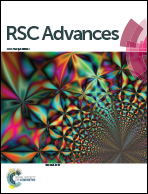A pharmaceutical cocrystal with potential anticancer activity†
Abstract
The design of pharmaceutical cocrystals has become a prime thrust of crystal engineering and the pharmaceutical industry in recent times – but the use of pharmaceutical cocrystals as regular drugs is yet to be explored. Quinoxaline acts as a basic skeleton of several potential anticancer drugs. We have successfully cocrystallized quinoxaline with another organic molecule 3-thiosemicarbano-butan-2-one-oxime (TSBO, a virus replication inhibitor) and examined the anticancer activity of the cocrystal. The crystal structure of the cocrystal was determined by single crystal X-diffraction study. According to thermogravimetric study the cocrystal exhibits better thermal stability than quinoxaline. UV-Vis spectroscopic study has shown that in solution state the behavior of the cocrystal and the physical mixture of its components (mixture of quinoxaline and TSBO) are significantly different. The solubility of the cocrystal in distilled water has been found to be 31.9 mg mL−1. The cocrystal exhibits a specific cytotoxic effect on lung cancer cells (A549) at 10−7 M concentration while it shows growth inhibitory effect on normal cells. The detailed mechanistic study of the cytotoxicity of the cocrystal suggests that it follows the mitochondrial mediated cell death pathway through activation of Caspase 9 and Bax. It also shows anticancer activity on breast cancer cells (MCF-7).


 Please wait while we load your content...
Please wait while we load your content...